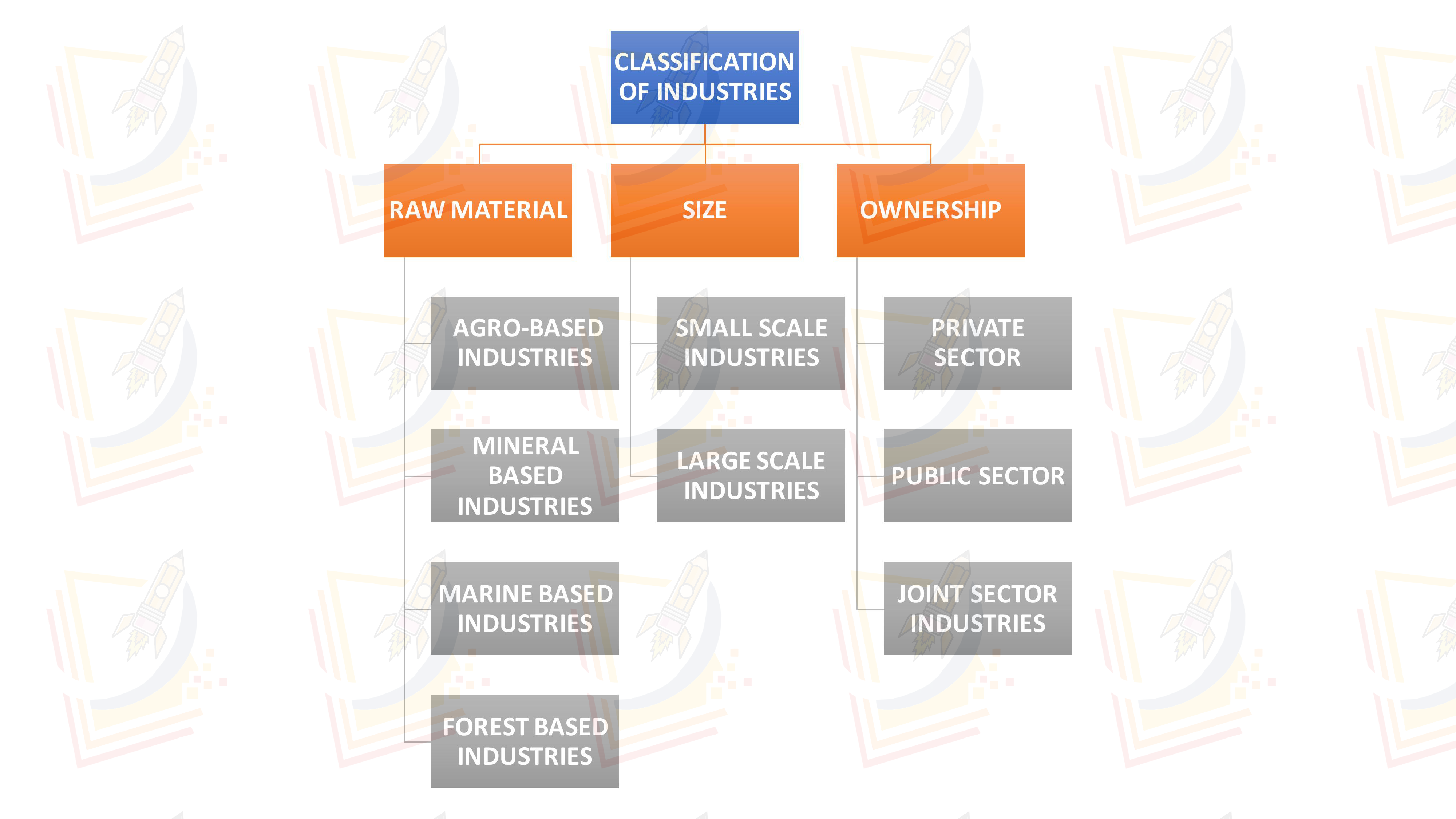INTRODUCTION
Industries are part of the secondary activity. In which manufacture converts raw material into final products. Industries refer to economic activities concerned with the production of goods, extraction of services etc.
- Production of goods
- Extraction of minerals
- Provision for services
- Emerging industries
CLASSIFICATION OF INDUSTRIES

RAW MATERIAL
- AGRO-BASED INDUSTRIES :- These industries use plants and animal based products as their raw materials. FOR EXAMPLE : - cotton textile, dairy
products. - MINERAL BASED INDUSTRIES : - These industries are based on mining and use mineral ore as raw material.
- MARINE BASED INDUSTRIES : - Marine based industries used raw material from sea and ocean. FOR EXAMPLE : - fish, oil
- FOREST BASED INDUSTRIES : - These industries used raw material from the forest. FOR EXAMPLE : - wood
SIZE
- SMALL SCALE INDUSTRIES : - Small industries have less capital and technology invested in them. FOR EXAMPLE : - Basket weaving, pottery, and handicrafts.
- LARGE SCALE INDUSTRIES : - large scale industries are the exact opposite of small scale industries. Here the capital invested is large and advance technology is in use here. FOR EXAMPLE :- Automobiles and heavy industries
OWNERSHIP
- PRIVATE SECTOR :- Private industries are businesses that are owned and operate by an individual or groups of individuals.
- PUBLIC SECTOR :- Public industries are owned and managed by the government
- JOINT SECTOR INDUSTRIES :- These industries are jointly operated by the state.
PROBLEMS OF INDUSTRIAL DEVELOPMENT

- UNBALANCED INDUSTRIAL STRUCTURE :- Despite all efforts India has not been able to attain self sufficiency in respect of industrial material. India is still dependent on foreign imports for transport equipments, machineries (electrical and non-electrical), iron and steel, paper, chemicals and fertilisers, plastic material etc. In the total industrial production consumer goods contribute 38 per cent. In newly industrialised countries like Singapore, South Korea and Malaysia this percentage is 52, 29 and 28 respectively.
- LOW DEMAND :- There is low demand for industrial products in the country due to low consumption level, weak purchasing power and poor standard of living. The domestic market is chronically underdeveloped through lack of enthusiasm generated by the middle and upper class segment who do not wish to raise their standard and improve their living conditions.
- REGIONAL CONCENTRATION :- In India most of the industries are located in few selected areas leaving out vast expanse of the country devoid of industrial establishments. Most of the industries are located in and around metropolitan cities like Mumbai, Kolkata, Delhi etc
- LOSS IN PUBLIC SECTOR INDUSTRIES :- Owing to focus on socialistic pattern of development investment under public sector industries increased phenomenally during early five year plans. But due to defective policy of the government characterised by redtops and inefficiency and strained labour management relations most of these public sector enterprises are running in loss.
- INDUSTRIAL SICKNESS :- In the private industrial sector a growing number of industrial units are becoming sick. Widespread sickness has, indeed, become a major problem of this sector. The causal factors for this sickness are:
- Deficient Management,
- Under-Utilisation Of Capacity Due To Shortage Of Raw Materials, Coal And Power And Transport,
- Obsolete Machinery, Equipment And Production Techniques,
- Uneconomical Scale Of Production,
- Faulty Choice Of Products And Processes,
- Difficulties In Selling The Products,
- Diversion Of Funds To New Units Under Same Ownership, And
- Conflict Between Different Interest Groups Among The Owners
- LACK OF INFRASTRUCTURE :- An inadequate infrastructural facility is another major problem faced by the Indian industries. Energy crisis has a great bearing on the industrial development and production. Although the installed capacity of electricity increased from 66.08 million km in 1990-91 to 85.79 million km in 1996-97 but it is much short of the actual demand.
- IMPROPER LOCATION BASE :- Industrial locations, in several instances, were established without reference to cost-effective points. Each state clamors for the establishment of major industries in the public sector within its boundaries, and the location decisions are often politically motivated.
- LACK OF CAPITAL :- Indian industrial development is facing acute shortage of capital. The short-term and long-term loans from international agencies like World Bank and Asian Development Bank etc have done more harm to the economy than taking it out from the crisis. A lot of foreign exchange is being utilised in the payment of these loans.
- LICENSE POLICY :- The license policy approving the site, capacity, type and expansion of industries is a typical example of excessive state interference and red tapes which hinder the industrial development.
